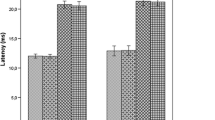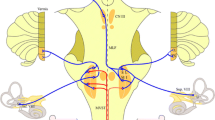Abstract
Aim/background
Essential tremor (ET) is one of the most common movement disorders. However, its pathogenesis is unclear. Human vestibular reflexes are essential not only for gait and posture but also for goal-directed voluntary movements. In this study, cervical vestibular–evoked myogenic potentials (cVEMPs), the electrophysiological equivalent of the vestibulo-collic reflex was studied in ET patients to understand the interaction between the tremor network and the vestibular neural pathways.
Methods
cVEMPs were recorded in 40 ET patients and 40 age and sex-matched healthy controls (HCs). The latencies of peaks p13 and n23 and peak-to-peak amplitude of p13-n23 were measured.
Results
There was no statistically significant difference between the p13 latencies of the HC and ET groups (p 0.79 and p 0.23 for the right and left sides respectively). n23 latency was shortened bilaterally in the ET group (p 0.009 and p 0.02 for the right and left sides respectively). p13-n23 amplitudes of the ET patients were bilaterally reduced when compared with the HC (p <0.001 and p 0.001 for the right and left sides respectively).
Conclusion
Information provided by vestibular afferents is crucial in the control of voluntary movements in humans. Despite this silent but significant effect, the role of the vestibular system in movement disorders is often overlooked. In this study, it was found that cVEMP responses reflecting the activity of the vestibulo-collic pathway were affected in ET which can be either caused by dysfunctional structures or pathways responsible from ET or an additional disorder of vestibular information processing in these patients.
Similar content being viewed by others
References
Louis ED, Ferreira JJ (2010) How common is the most common adult movement disorder? Update on the worldwide prevalence of essential tremor. Mov Disord 25:534–541
Bhatia KP, Bain P, Bajaj N, Rodger JE, Hallett M, Elan DL et al (2018) Consensus statement on the classification of tremors. From the task force on tremor of The International Parkinson’s and Movement Disorder Society. Mov Disord 33:75–87
Hopfner F, Deuschl G (2018) Is essential tremor a single entity? Eur J Neurol 25(1):71–82
Reichenbach A, Bresciani JP, Bülthoff HH, Thielscher A (2016) Reaching with the sixth sense: vestibular contributions to voluntary motor control in the human right parietal cortex. Neuroimage 124(Pt A):869–875
Louis ED, Faust PL (2020) Essential tremor pathology: neurodegeneration and reorganization of neuronal connections. Nat Rev Neurol 16(2):69–83
Rosengren SM, Colebatch JG, Young AS, Govender S, Welgampola MS (2019) Vestibular evoked myogenic potentials in practice: methods, pitfalls and clinical applications. Clin Neurophysiol Pract 4:47–68
Uchino Y (1997) Connections between otolith receptors and neck motoneurons. Acta Otolaryngol 528:49–51
Raethjen J, Govindan RB, Kopper F, Muthuraman M, Deuschl G (2007) Cortical involvement in the generation of essential tremor. J Neurophysiol 97:3219–3228
Schnitzler A, Munks C, Butz M, Timmermann L, Gross J (2009) Synchronized brain network associated with essential tremor as revealed by magnetoencephalography. Mov Disord 24:1629–1635
Muthuraman M, Heute U, Arning K, Anwar AR, Elble R, Deuschl G, Raethjen J (2012) Oscillating central motor networks in pathological tremors and voluntary movements. What makes the difference? Neuroimage 60:1331–1339
Helmich RC, Toni I, Deuschl G, Bloem BR (2013) The pathophysiology of essential tremor and Parkinson’s tremor. Curr Neurol Neurosci Rep 13:378
Pan MK, Li YS, Wong SB et al (2020) Cerebellar oscillations driven by synaptic pruning deficits of cerebellar climbing fibers contribute to tremor pathophysiology. Sci Transl Med 12(526):eaay1769
Haubenberger D, Hallett M (2018) Essential tremor. N Engl J Med 378:1802–1810
Louis ED, Faust PL, Vonsattel JP, Lawrence SH, Rajput A, Robinson CA et al (2007) Neuropathological changes in essential tremor: 33 cases compared with 21 controls. Brain 130:3297–3307
Yu M, Ma K, Faust PL, Honig LS, Cortés E, Vonsattel JPG, Louis ED (2012) Increased number of Purkinje cell dendritic swellings in essential tremor. Eur J Neurol 19:625–630
Erickson-Davis CR, Faust PL, Vonsattel JP et al (2010) “Hairy baskets” associated with degenerative Purkinje cell changes in essential tremor. J Neuropathol Exp Neurol 69:262–271
Clark LN, Lois ED (2018) Essential tremor. Handb Clin Neurol 147:229–239
Büttner U, Glasauer S, Glonti L, Kleine JF, Siebold C (1999) Otolith processing in the deep cerebellar nuclei. Ann N Y Acad Sci 871:81–93
Barmack NH (2003) Central vestibular system: vestibular nuclei and posterior cerebellum. Brain Res Bull 60(5-6):511–541
Walker TF, Tian J, Shan X, Tamargo RJ, Ying H, Zee DS (2010) The cerebellar nodulus/uvula integrates otolith signals for the translational vestibulo-ocular reflex. PLoS One 5(11):e13981
Voogd J, Schraa-Tam CKL, van der Geest JN, De Zeeuw CI (2012) Visuomotor cerebellum in human and nonhuman primates. Cerebellum 11(2):392–410
Shemesh AA, Zee DS (2019) Eye Movement disorders and the cerebellum. J Clin Neurophysiol 36(6):405–414
Baier B, Bense S, Dieterich M (2008) Are signs of ocular tilt reaction in patients with cerebellar lesions mediated by the dentate nucleus? Brain 131:1445–1454
Oh SY, Kim HJ, Kim JS (2016) Vestibular-evoked myogenic potentials in central vestibular disorders. J Neurol 263(2):210–220
Choi SY, Lee SH, Kim HJ, Kim JS (2014) Impaired modulation of the otolithic function in acute unilateral cerebellar infarction. Cerebellum 13(3):362–371
Versino M, Colnaghi S, Callieco R, Bergamaschi R, Romani A, Cosi V (2002) Vestibular evoked myogenic potentials in multiple sclerosis patients. Clin Neurophysiol 113(9):1464–1469
Alpini D, Pugnetti L, Caputo D et al (2004) Vestibular evoked myogenic potentials in multiple sclerosis: clinical and imaging correlations. Mult Scler 10(3):316–321
Bandini F, Beronio A, Ghiglione E, Solaro C, Parodi RC, Mazzella L (2004) The diagnostic value of vestibular evoked myogenic potentials in multiple sclerosis. J Neurol 251(5):617–62145
Eleftheriadou A, Deftereos SN, Zarikas V, Panagopoulos G, Sfetsos S, Karageorgiou CL, Ferekidou E, Kandiloros D, Korres S (2009) The diagnostic value of earlier and later components of vestibular evoked myogenic potentials (VEMP) in multiple sclerosis. J Vestib Res 19(1–2):59–66
Colebatch JG (2012) Vestibular evoked myogenic potentials in multiple sclerosis. Clin Neurophysiol 123(9):1693–1694
Kavasoğlu G, Gökçay F, Yüceyar N, Çelebisoy N (2018) Cervical vestibular-evoked myogenic potentials in patients with multiple sclerosis: sensitive in detecting brainstem involvement? Neurol Sci 39(2):365–371
Harun, Oh ES, Bigelow RT, Studenski S, Agrawal Y (2016) Vestibular impairment in dementia. Otol Neurotol 37:1137–1142
de Natale ER, Ginatempo F, Paulus KS, Manca A, Mercante B, Pes GM, Agnetti V, Tolu E, Deriu F (2015) Paired neurophysiological and clinical study of the brainstem at different stages of Parkinson’s disease. Clin Neurophysiol 126:1871–1878
Shalash AS, Hassan DM, Elrassas HH et al (2017) Auditory- and vestibular-evoked potentials correlate with motor and non-motor features of Parkinson’s disease. Front Neurol 8:55
Potter-Nerger M, Govender S, Deuschl G et al (2015) Selective changes of ocular vestibular myogenic potentials in Parkinson’s disease. Mov Disord 30:584–589
Pollak L, Prohorov T, Kushnir M, Rabey M (2009) Vestibulocervical reflexes in idiopathic Parkinson disease. Neurophysiol Clin 39:235–240
Welgampola MS, Colebatch JG (2005) Characteristics and clinical applications of vestibular evoked myogenic potentials. Neurology 64(10):1682–1688
Author information
Authors and Affiliations
Corresponding author
Ethics declarations
Ethics approval
This study was performed in line with the principles of the Declaration of Helsinki. Approval was granted by the Local Ethics Committee of Izmir Tepecik Education and Research Hospital (reference number 17-15/2016, approval date September 19th 2016). Informed consent was obtained from all participants included in the study. All authors gave their consent for publication. The data is available. All authors contributed to the publication of the study and manuscript.
Conflict of interest
The authors declare no competing interests.
Additional information
Publisher’s note
Springer Nature remains neutral with regard to jurisdictional claims in published maps and institutional affiliations.
Rights and permissions
About this article
Cite this article
Uyaroglu, F.G., Ucar, R., Acarer, A. et al. What might cervical vestibular–evoked myogenic potential abnormalities mean in essential tremor?. Neurol Sci 42, 5271–5276 (2021). https://doi.org/10.1007/s10072-021-05248-5
Received:
Accepted:
Published:
Issue Date:
DOI: https://doi.org/10.1007/s10072-021-05248-5




